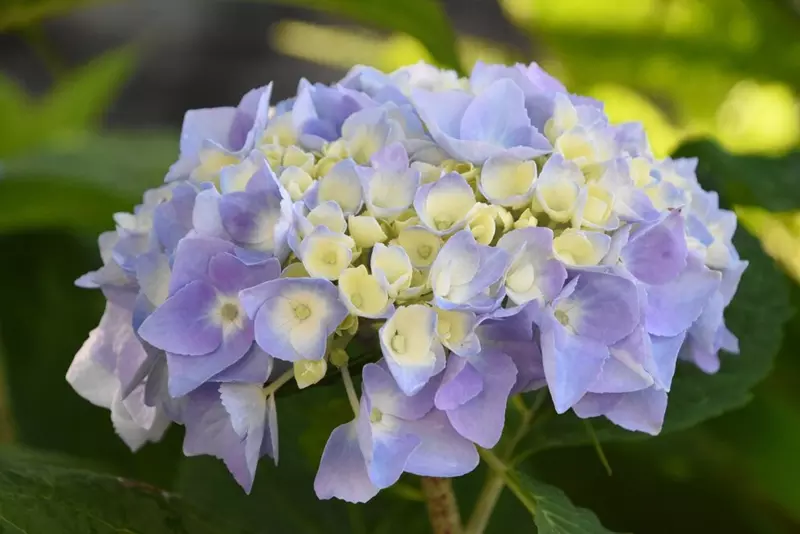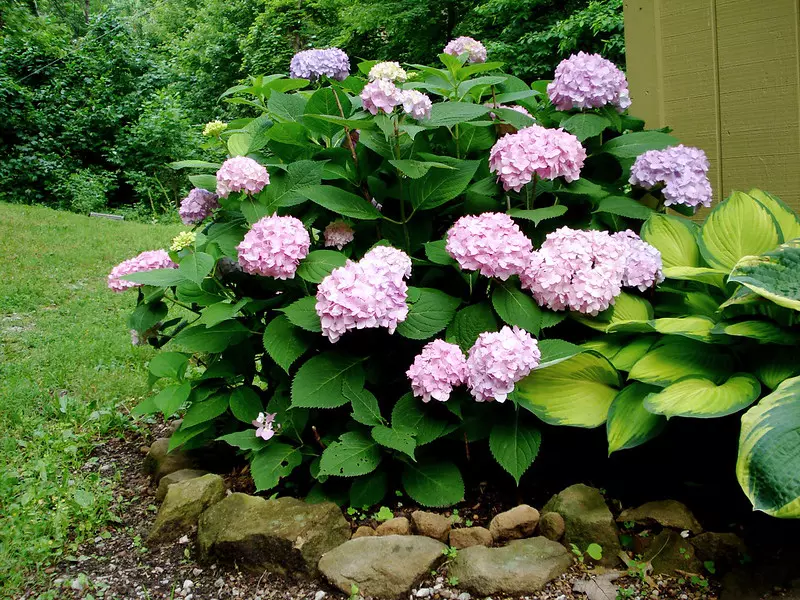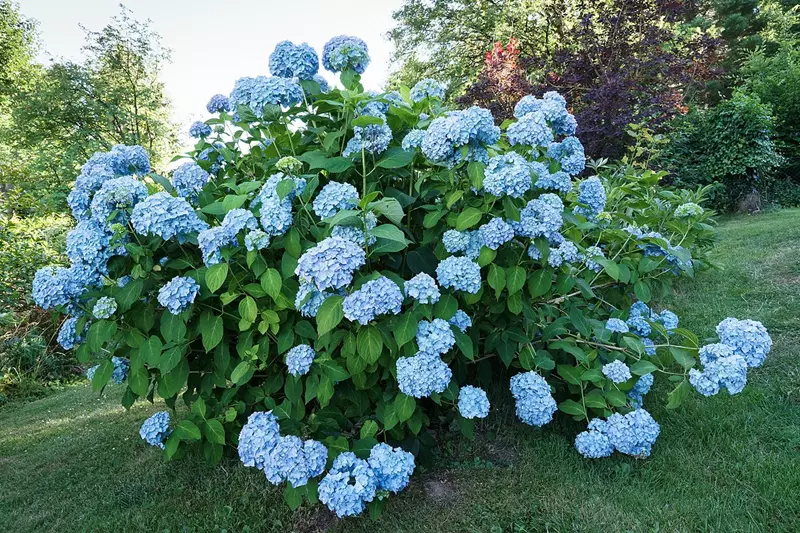
The Ultimate Guide to Hydrangea macrophylla (Garden Hydrangea)
A complete guide to Hydrangea macrophylla, including planting, pruning, soil adjustments, eco-friendly pest management, propagation, and garden design ideas.
Read MoreHydrangea macrophylla 'Twist and Shout', part of the Endless Summer® series, is renowned for its reblooming lacecap flowers and vibrant autumn foliage. This deciduous shrub typically reaches up to 1.5 metres in height and width, featuring reddish stems and ovate, serrated green leaves that turn deep red in autumn. The broad lacecap flower heads, produced on both new and old wood, extend the blooming season throughout the summer. Flower colours range from deep pink to deep purple-blue tones, influenced by soil pH.

'Twist and Shout' is ideal for gardeners seeking a low-maintenance, versatile shrub that offers extended blooming periods and seasonal interest. Its adaptability makes it suitable for both novice and experienced gardeners. Additionally, those interested in experimenting with soil pH to achieve different flower colours will find this variety particularly rewarding.
This hydrangea thrives in various garden settings, including:
Hydrangea macrophylla 'Twist and Shout' is a versatile and attractive addition to various garden settings. Its reblooming nature, vibrant autumn foliage, and adaptability make it a valuable choice for gardeners seeking prolonged seasonal interest. However, considerations regarding sunlight exposure, soil pH management, and climate suitability are essential to ensure optimal performance.
Before planting, it’s essential to prepare the hydrangea to minimise transplant shock and support healthy root establishment:
'Twist and Shout' thrives in well-draining soil rich in organic matter. Select a site with morning sun and afternoon shade to protect it from harsh midday heat. Avoid areas prone to waterlogging, as this can cause root rot.
After planting, continue to care for your hydrangea to help it establish:
'Twist and Shout' adapts well to various soil types, provided they are well-draining. Avoid planting in heavy clay soils unless amended with organic matter. For optimal flowering, ensure the soil pH suits your colour preference: acidic for blue flowers, alkaline for pink.
By following these planting guidelines, Hydrangea macrophylla 'Twist and Shout' will establish successfully and reward you with its stunning blooms and vibrant foliage. Proper preparation, site selection, and post-planting care are vital to ensuring this hydrangea thrives in your garden.
Hydrangea macrophylla 'Twist and Shout' thrives in moist, well-drained soils rich in organic matter. Incorporating compost or well-rotted manure enhances soil fertility and structure, promoting healthy root development.
The flower colour of 'Twist and Shout' is influenced by soil pH:
Regular soil testing is recommended to monitor pH levels and adjust accordingly.
While 'Twist and Shout' prefers consistently moist soil, adequate drainage is crucial to prevent root rot. Avoid planting in areas prone to waterlogging. Applying a 2-3 inch layer of organic mulch helps retain moisture and regulate soil temperature.
Enhancing soil quality benefits 'Twist and Shout':
Amending the planting site with organic matter fosters a favourable environment for growth.
Providing Hydrangea macrophylla 'Twist and Shout' with well-drained, organically rich soil and appropriate pH levels ensures vibrant blooms and robust health. Regular soil assessment and thoughtful amendments are key to cultivating this hydrangea successfully.
Proper watering is essential for the health and vitality of Hydrangea macrophylla 'Twist and Shout'. This reblooming lacecap hydrangea requires consistent moisture to produce its characteristic vibrant blooms and lush foliage.
To maintain optimal soil moisture:
Environmental factors influence watering needs:
Applying a 2-3 inch (5-7.5 cm) layer of organic mulch around the base of the plant helps retain soil moisture, regulate temperature, and suppress weeds. Ensure the mulch is kept a few inches away from the stem to prevent rot.
Monitor the plant for indicators of watering issues:
Maintaining a consistent and appropriate watering schedule is crucial for the success of Hydrangea macrophylla 'Twist and Shout'. By adjusting watering practices to environmental conditions and employing mulching techniques, gardeners can ensure this hydrangea thrives and displays its full ornamental potential.
Hydrangea macrophylla 'Twist and Shout' flourishes in partial shade, ideally receiving morning sunlight followed by afternoon shade. This exposure balances the plant's need for light while protecting it from the intense heat of midday sun, which can cause wilting and leaf scorch.
Sunlight requirements may vary based on regional climates:
When choosing a planting location, consider the following:
Monitor your hydrangea for signs of improper light exposure:
Providing the appropriate balance of sunlight and shade is essential for the health and beauty of Hydrangea macrophylla 'Twist and Shout'. Tailoring light exposure to your regional climate and monitoring the plant's response will ensure vibrant blooms and robust growth.
Applying a 2- to 6-inch layer of organic compost into the soil before planting provides essential nutrients and improves soil structure. Compost enriches the soil with organic matter, fostering beneficial microbial activity and enhancing moisture retention.
Integrating well-rotted manure into the planting area supplies a slow-release source of nutrients. Manure enhances soil fertility and promotes robust root development, contributing to the overall health of the hydrangea.
Spreading a 2- to 3-inch layer of organic mulch, such as shredded leaves or leaf mould, around the base of the plant helps retain soil moisture, regulate temperature, and suppress weeds. As the mulch decomposes, it adds valuable organic matter to the soil, further enriching its nutrient content.
The flower colour of 'Twist and Shout' varies with soil pH:
Regular soil testing is recommended to monitor pH levels and make informed adjustments.
For optimal results, apply organic compost or well-rotted manure in early spring, just as new growth begins. A second application in early summer can support continuous blooming. Avoid fertilising after mid-summer to prevent stimulating new growth that may not harden off before winter.
Employing natural fertilisation methods for Hydrangea macrophylla 'Twist and Shout' enhances plant health and contributes to a sustainable garden ecosystem. Incorporating organic compost, well-rotted manure, and mulch, along with mindful soil pH adjustments, fosters vigorous growth and abundant, colourful blooms.
Contrary to common belief, Hydrangea macrophylla 'Twist and Shout' should be pruned exclusively in spring, after the danger of frost has passed, typically around March. Avoid autumn pruning, as this hydrangea is sensitive to frost; cutting back in autumn can expose upper buds to frost damage, jeopardising the next season's blooms.
This variety blooms on old wood, meaning it produces flowers on the previous year's growth. Therefore, avoid drastic pruning. Instead, remove only the spent flower heads, cutting just above the first pair of strong buds. Severe pruning can eliminate potential flowering buds, resulting in reduced or absent blooms.
If branches have suffered frost damage or if thinning is necessary, remove affected stems at the base. This selective removal encourages healthy growth without compromising the plant's flowering potential.
When taking cuttings for propagation, be aware that the branches used are unlikely to produce flowers that year. Select propagation material judiciously to balance between propagation efforts and maintaining the plant's ornamental display.
Proper pruning of Hydrangea macrophylla 'Twist and Shout' involves timely and minimal cuts to preserve the buds that will become the next season's flowers. By adhering to these guidelines, gardeners can ensure a vibrant and floriferous display.
Hydrangea macrophylla 'Twist and Shout' is susceptible to several pests that can compromise its health and appearance:
This hydrangea variety is also prone to several diseases:
To maintain the health of 'Twist and Shout' hydrangeas, consider the following practices:
By implementing vigilant monitoring and adopting appropriate cultural practices, gardeners can effectively manage and prevent the common pests and diseases that affect Hydrangea macrophylla 'Twist and Shout', ensuring a healthy and vibrant display.
Hydrangea macrophylla 'Twist and Shout' is sensitive to cold temperatures, particularly in regions where winter temperatures drop below -15°C (5°F). In such climates, the plant's buds and stems are susceptible to frost damage, which can adversely affect blooming in the following season.
Implement winter protection strategies in late autumn, just before the first hard frost. This timing ensures that the plant is shielded from the onset of freezing temperatures without creating conditions that encourage pest habitation or disease.
Apply a 5- to 10-centimetre (2- to 4-inch) layer of organic mulch, such as shredded leaves or straw, around the base of the plant. This mulch acts as insulation, protecting the roots and the crown from temperature fluctuations and frost heaving.
For additional protection, especially in colder zones, consider wrapping the entire plant:
Potted 'Twist and Shout' hydrangeas require special attention:
Regularly check the plant throughout the winter months:
As temperatures rise in spring:
By implementing these winter protection strategies, gardeners can safeguard Hydrangea macrophylla 'Twist and Shout' against cold damage, ensuring a vibrant and floriferous display in the subsequent growing season.
Selecting appropriate companion plants for Hydrangea macrophylla 'Twist and Shout' enhances the aesthetic appeal and health of your garden. Ideal companions share similar growing conditions, such as partial shade and moist, well-draining, slightly acidic soil. They also provide complementary textures, colours, and bloom times, creating a harmonious and dynamic landscape.
Certain plants are incompatible with hydrangeas due to differing soil and light preferences or competitive growth habits:
Thoughtfully selecting companion plants for Hydrangea macrophylla 'Twist and Shout' fosters a cohesive and thriving garden environment. By choosing plants with similar cultural requirements and complementary characteristics, you can create a visually appealing and healthy landscape.
With its extended blooming period and captivating flowers, Hydrangea macrophylla 'Twist and Shout' is a valuable addition to any garden. Adhering to proper planting, care, and maintenance practices ensures this hydrangea thrives, offering beauty throughout the growing season.

A complete guide to Hydrangea macrophylla, including planting, pruning, soil adjustments, eco-friendly pest management, propagation, and garden design ideas.
Read More
Comprehensive guide on Hydrangea macrophylla 'Endless Summer'. Learn expert tips on planting, care, pruning, and maintaining vibrant blooms.
Read More
Discover the beauty and care techniques for Hydrangea macrophylla 'Nikko Blue'. Learn how to grow, maintain, and enjoy this stunning blue-flowering hydrangea.
Read More